Background:
The bicooler setup that combines a stock location intercooler with a smaller front mounted intercooler in front of the AC condenser gets disparaged routinely.
The question I decided to investigate is, just how “bad” is the bicooler?
The principle the bicooler follows is straight forward, the greater heat transfer area that an intercooler has the more heat can be removed from the charge air.
For that reason it would seem reasonable that a bicooler can improve the cooling performance over a stock location intercooler operating independently.
A specific knock against the bicooler is that the branching of the silicone hoses causes “turbulence” that hurts airflow through the system.
That idea has some merit, but I have never seen a test performed to show there is a significant affect on airflow. Focusing on the hose design overlooks the more significant source of turbulence and pressure drop of the intercooler system, the IC core.
It begs the question of whether the people who are concerned about the junction of the bicooler hose have peered into the core of an intercooler to see what the air has to pass through. Creating turbulence in the air is done purposefully to aid with heat transfer out of the charge air.
Relative to the turbulence created by the intercooler core the silicone hose branch is likely negligible. Additionally, pressure drop is a function of the square of the airflow velocity and by having two cores the velocity through each is lowered, reducing pressure drop.
The additional core is analogous to the multiple lane street versus single lane street in the picture below. The extra lane of the bicooler means that the same amount of “traffic” (airflow) can pass through the bicooler core pair at a slower speed, improving pressure drop that results from drag forces on the moving air.
Pressure Drop Test:
How does the bicooler compare with the stand alone stock location intercooler when tested for pressure drop?
Comparing the airflow through the stock GTI IC and the bicooler:
The bicooler produces a 34% increase in airflow versus the stock GTI IC alone.
On my GTI when operating at 24 psi of boost around 6,500 RPM the stock IC shows a pressure drop of 3.4 psi versus the bicooler causing a pressure drop of 1.8 psi.
Pressure drop of stock GTI IC:
Pressure Drop with the Bicooler:
On average, with all of the bicooler and single core combinations that have been tested, the bicooler configuration improves pressure drop by ~1.2 psi
Conclusion – the bicooler substantially improves airflow versus a single core.
Cooling Performance:
Cooling performance from the bicooler is also questioned, the rationale being that since the stock intercooler is still being used it causes much of the charge air to heat up, even if the front core is producing cooler charge air.
Driving results using a bicooler are shown on the next three charts:
Close-up of pulls:
Single pull data:
Comparing this with the Stock GTI IC:
Combining the IAT data for several pulls in the chart below the bicooler produces relatively steady intake air temperature whereas the stock GTI IC shows an upward climb of IAT as the engine speed increases.
On average the bicooler produces a temperature increase of 11 degF at 6,000 rpm during a 3rd gear pull with the boost profile shown in the chart above.
This result compares favorably with all stand alone and combination Intercooler setups that have been tested.
The next chart shows the stock location intercoolers that have been installed on my GTI and the data points I have measured during acceleration testing. The rightmost entries are the stock GTI IC and then the GTI with bicooler.
Conclusion – the bicooler substantially improves cooling performance versus the stock IC.
Boost Onset:
Another knock against the bicooler is that it results in a tremendous volume increase, that the turbocharger needs longer to pressurize the added volume, and consequently boost builds more slowly.
This is another “sounds reasonable” concern, but is it realized in practice?
In a previous post I discussed the volume change with the bicooler and the impact the added volume has on boost onset time. The results with an IS20 are shown again here:
The time it takes for boost to build from 1 psi to 20 psi is effectively unchanged.
Next is a similar comparison but using a Shuenk IS38+ turbocharger and ARM front mount intercooler paired with the stock GTI intercooler:
Again the time for boost to build is effectively unchanged.
To illustrate the sensitivity of this measurement to changes, a dataset was recorded when outside air temperature was approximately 20 degF cooler than normal. The orange line shows how the boost onset time was affected by the colder air temperatures.
A third comparison is made using the do88 stock location intercooler, a core that is roughly double the “volume” of a stock GTI IC.
Note: Volume is in quotes because measuring the exterior dimensions of an IC and calculating volume is misleading since much of the core volume is used for external air passage. Filling the IC with water and measuring the quantity of water would be a better method for determining the volume.
The do88 intercooler is combined with the Majesty FMIC and boost onset measured. Results compared to a stock location aftermarket intercooler from CTS Turbo are shown:
In this configuration the trend line shows that there is some difference between the do88+bicooler and stock location only. Boost onset is delayed approximately 0.2 seconds on average.
Note: There is a fair amount of spread in the data which means sometimes the difference is less, and sometimes it is more.
Note: For a sense of how much of a delay 0.2 seconds is, enter “Stopwatch” in a Google Search bar. Use the “Start” then “Stop” function on the APP and try to achieve a time of: 0 s 20
A second comparison looking at boost onset versus rpm, instead of time, is made in the next chart that shows the do88 intercooler alone, versus having the FMIC attached.
There is no discernable change in the boost onset between these two cases.
Note: The orange line is shifted right due to pressing the accelerator at a slightly higher starting rpm. If the pedal had been pressed at the same engine RPM the orange line would overlay the blue as the partial red line does.
Conclusion – Affect on boost onset from the bicooler configuration ranges from undetectable to slight (~0.2 seconds)
Conclusions:
The addition of a bicooler to the GTI intercooler produces positive changes to pressure drop, cooling, and has little to no impact on boost onset.
From a performance perspective none of these tests point to a reason to avoid using a bicooler.
Note: Affect on AC performance has been researched before.
Next: Bicooler versus aftermarket stock location intercooler.




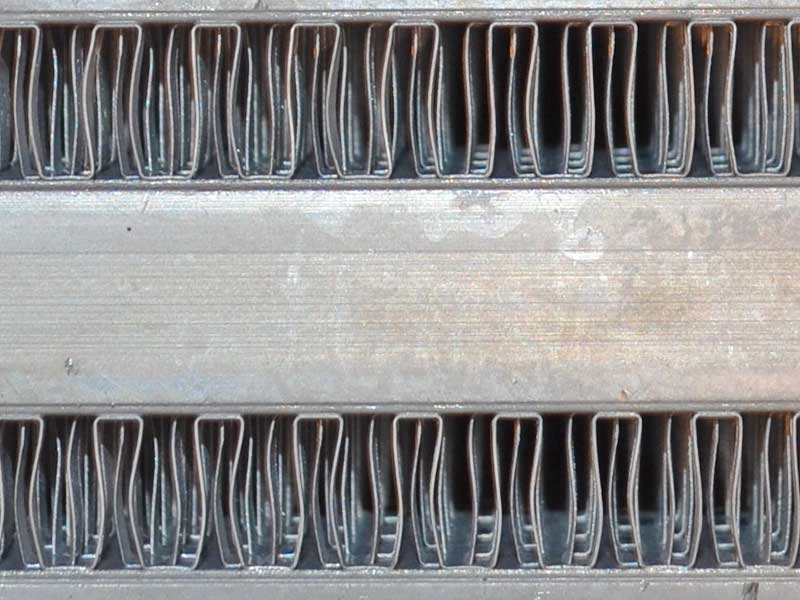


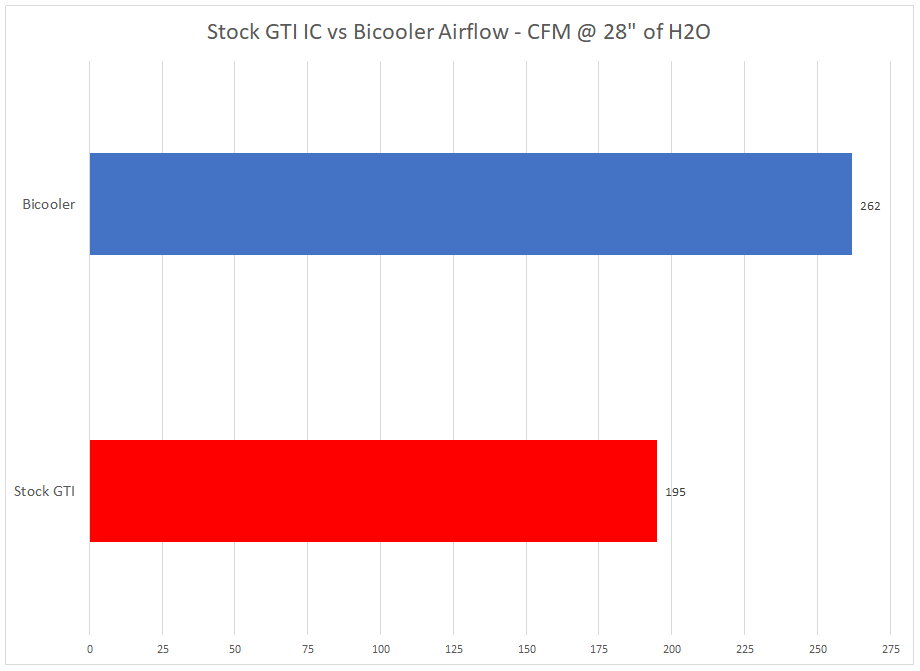
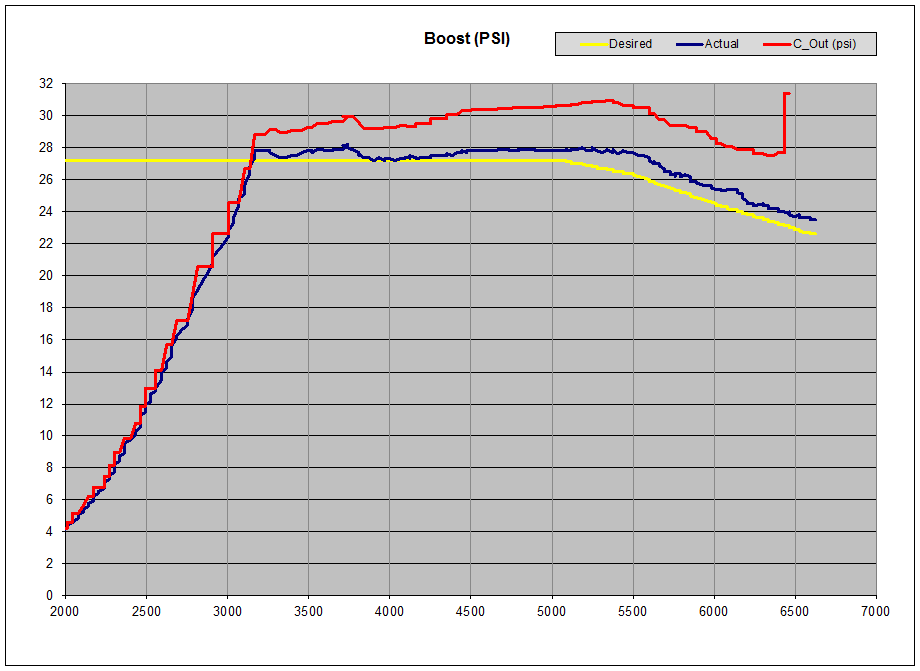

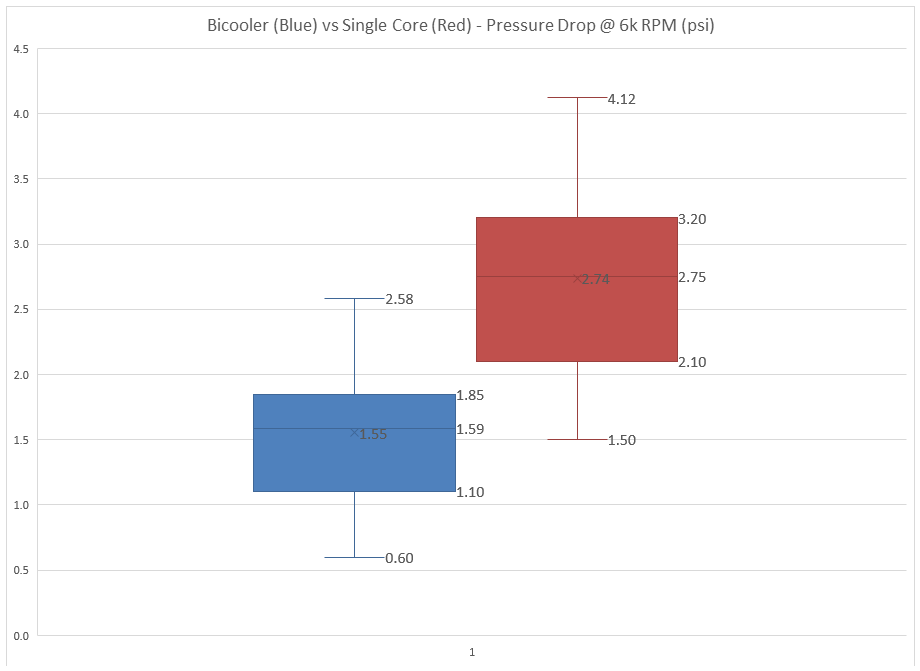
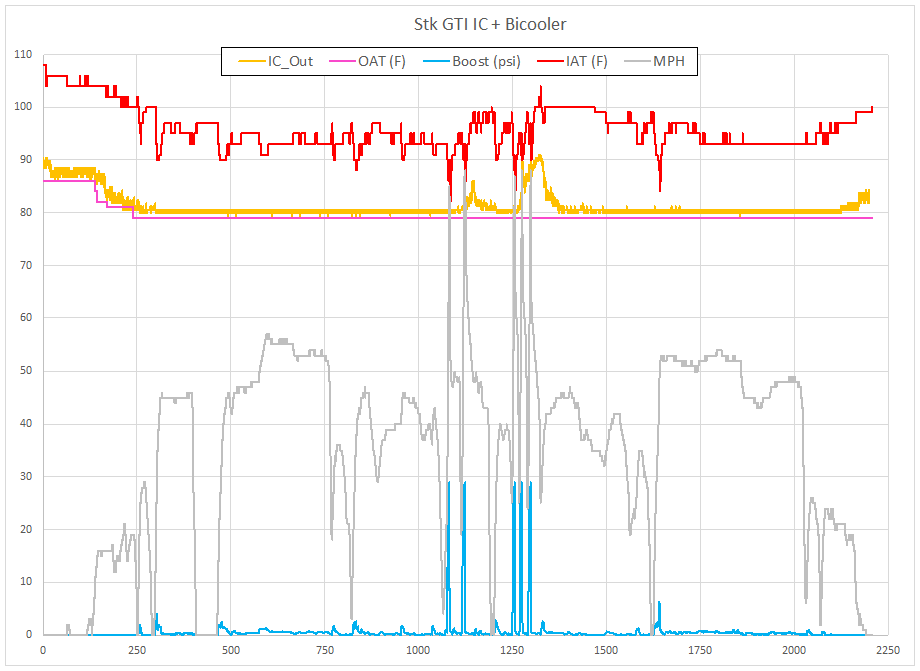


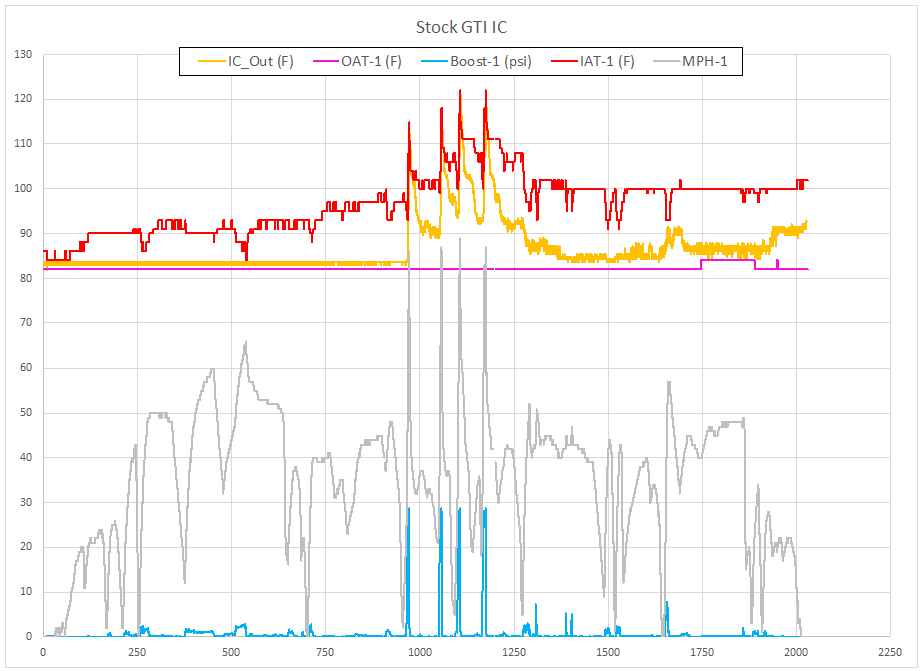





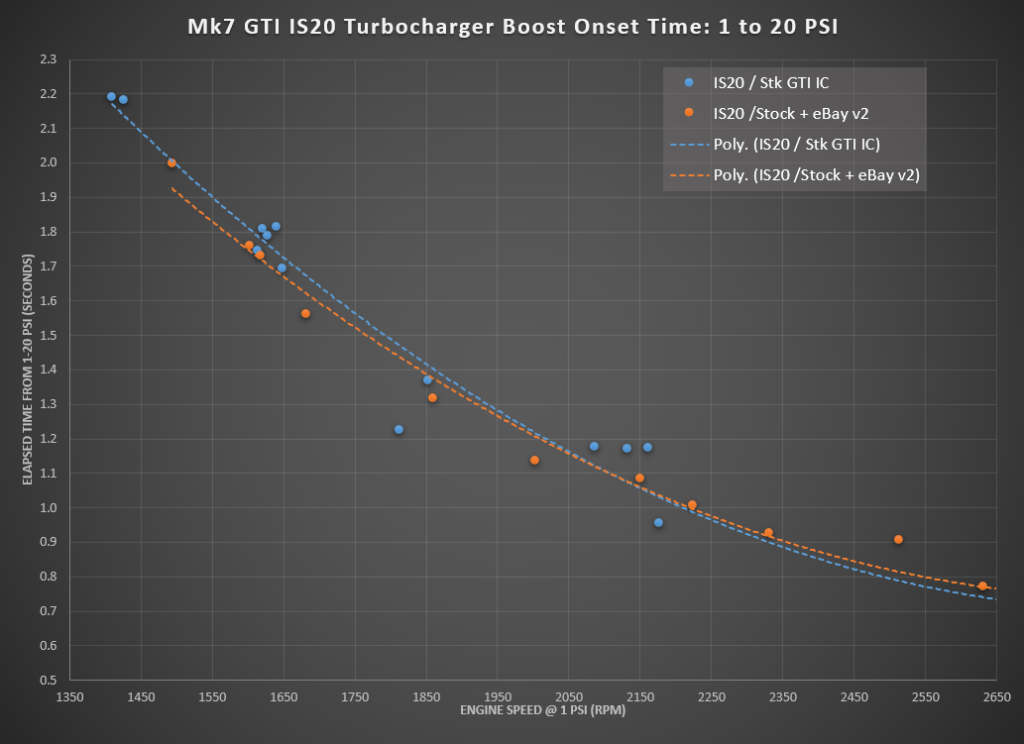

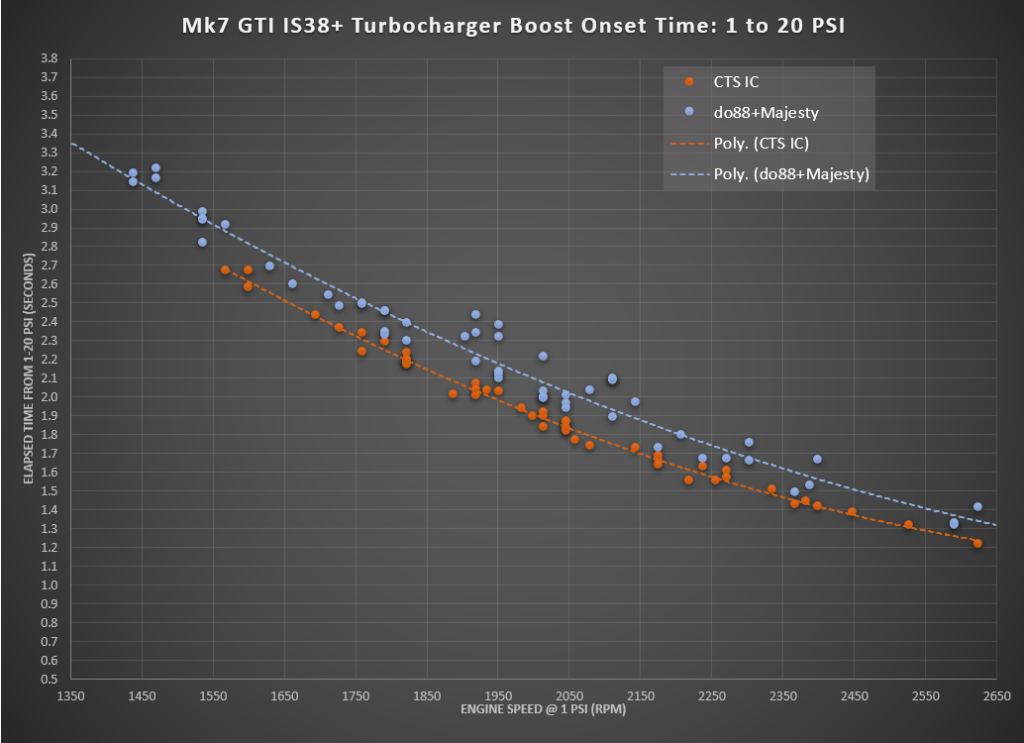

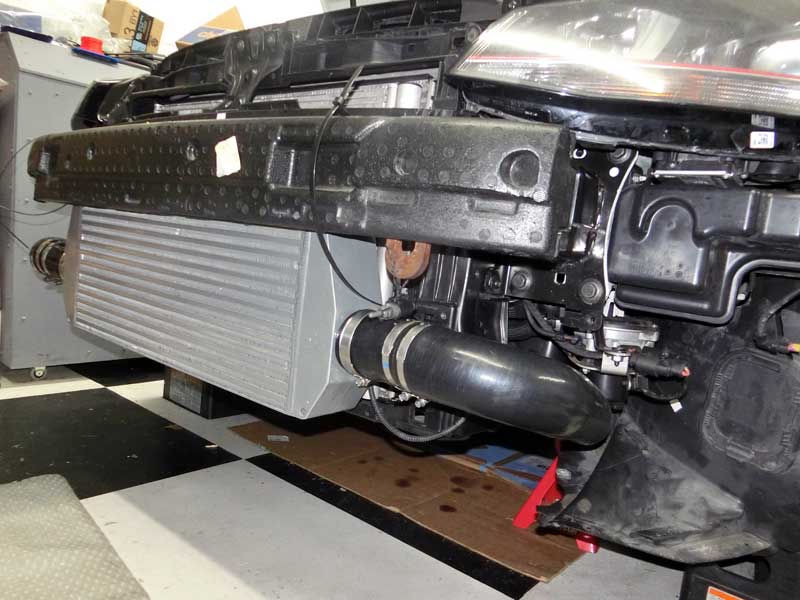
Awesome info, I am looking to go is38 soon and love the look of a fmic over larger stock location but constantly see the advice to avoid them. I am not going to be racing so glad to see there is some positive data around this option! I am assuming install is also easier. Love the site I visit often!
I don’t know if you read comments from old post. I just found your site and I love it. I have one question about the Majesty Bicooler. On E bay, the Majesty I found is also listed as CSK Performance. Is this the same bicooler you tested ??? Thanks…
I believe that is the same product. The hoses with the Majesty unit I have show CSK on them.